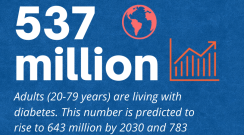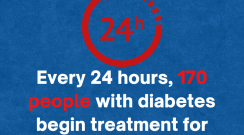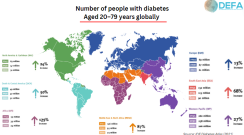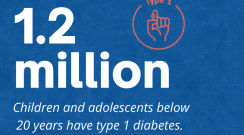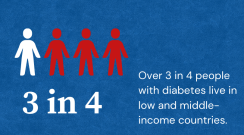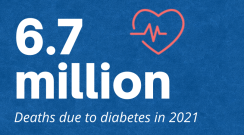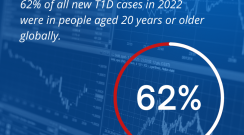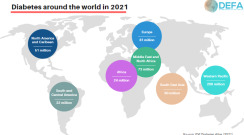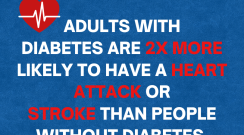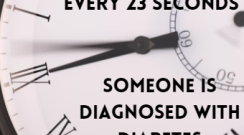Explore comprehensive statistical insights into diabetes trends, prevalence, and management throughout the year 2021. (Highlights In 2021 International Diabetes Federation (IDF) estimates)
- Posted: 06 December 2023
This statistic highlights that out of every 10 adults, one individual is living with diabetes, with nearly half of them being undiagnosed. This information underscores the prevalence of diabetes and the need for increased awareness, education, and early detection efforts.
- Posted: 06 December 2023
This figure represents the millions of adults aged between 20 and 79 years who are currently living with diabetes. Projections indicate that this number is expected to increase to 643 million by the year 2030 and further to 783 million by 2045. These forecasts highlight the significant challenge posed by the rising prevalence of diabetes worldwide and the importance of preventative measures and improved management strategies.
- Posted: 06 December 2023
This statistic reveals that one out of every three American adults is affected by prediabetes, a condition characterized by elevated blood glucose levels that increase the risk of developing type 2 diabetes. This serves as a critical reminder of the importance of early detection, lifestyle modifications, and preventive measures to avert the onset of full-fledged diabetes.
- Posted: 06 December 2023
Every 24 hours, 170 individuals with diabetes initiate treatment for kidney failure, emphasizing the significant impact of diabetes on renal health. This statistic underscores the urgent need for proactive management of diabetes to prevent complications such as end-stage renal disease.
- Posted: 06 December 2023
This statistic represents the total count of individuals worldwide between the ages of 20 and 79 who are affected by diabetes. It serves as a key indicator of the global burden of diabetes and highlights the importance of awareness, prevention, and management strategies on a global scale.
- Posted: 07 December 2023
This statistic illustrates that 1.2 million children and adolescents below the age of 20 are diagnosed with type 1 diabetes. This data highlights the prevalence of this chronic condition among younger age groups and emphasizes the importance of early diagnosis and management in pediatric populations.
- Posted: 07 December 2023
This statistic indicates that more than three-quarters of individuals with diabetes reside in low and middle-income countries, emphasizing the global distribution of the disease. It emphasizes the need for targeted interventions, resources, and support in these regions to address the challenges associated with diabetes care and management.
- Posted: 07 December 2023
This statistic represents the staggering number of deaths attributed to diabetes in the year 2021. It reflects the significant impact of diabetes on mortality rates globally and highlights the importance of effective prevention, management, and treatment strategies to reduce the burden of the disease.
- Posted: 07 December 2023
This statistic reveals that one in six live births, amounting to 21 million globally, are affected by hyperglycemia during pregnancy. Around 80% of these cases are linked to mothers with Gestational Diabetes Mellitus (GDM). This data underscores the prevalence of hyperglycemia in pregnancy and the associated risks for both mothers and babies, highlighting the importance of early detection and management.
- Posted: 07 December 2023
This data highlights the prevalence of Type 1 Diabetes in adults and emphasizes the need for awareness, early detection, and appropriate management strategies across all age groups.
- Posted: 07 December 2023
This statistic shows worldwide diabetes insights for 2021.
- Posted: 07 December 2023
Approximately one-third of individuals with diabetes are estimated to have kidney disease, highlighting the substantial prevalence of diabetic nephropathy among this population. This statistic emphasizes the importance of regular screening, early intervention, and comprehensive management to address the impact of diabetes on kidney health.
- Posted: 07 December 2023
This statistic emphasizes the heightened cardiovascular risk faced by those living with diabetes, underscoring the importance of effective management strategies to prevent such serious complications.
- Posted: 07 December 2023
Every 5 seconds, a life is lost to diabetes, underscoring the significant impact of this chronic condition on global mortality rates. This statistic highlights the urgent need for improved prevention, management, and access to healthcare services to mitigate the devastating effects of diabetes-related complications.
- Posted: 07 December 2023
This statistic underscores the growing prevalence of diabetes and the need for heightened awareness, early detection, and effective management strategies to address this global health issue.


